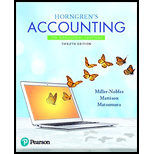
Horngren's Accounting (12th Edition)
12th Edition
ISBN: 9780134486444
Author: Tracie L. Miller-Nobles, Brenda L. Mattison, Ella Mae Matsumura
Publisher: PEARSON
expand_more
expand_more
format_list_bulleted
Concept explainers
Textbook Question
Chapter 2, Problem E2.11E
Creating a chart of accounts
Learning Objective 1
Raymond Autobody Shop has the folowing accounts:
| Accounts Payable | Service Revenue |
| Cash | Equipment |
| Utilities Expense | Raymond, Capital |
| Automotive Supplies | Advertising Expense |
| Raymond, Withdrawals | Unearned Revenue |
Create a chart of accounts for Raymond Autobody Shop using the standard numbering system. Each accounts is separated by a factor of 10. For example, the fist asset account will be 100 and the next asset account will 110.
Expert Solution & Answer
Want to see the full answer?
Check out a sample textbook solution
Students have asked these similar questions
General accounting question
provide correct answer
Hi expert please give me answer general accounting question
Chapter 2 Solutions
Horngren's Accounting (12th Edition)
Ch. 2 - The detailed record of the changes in a particular...Ch. 2 - Which of the following accounts is a liability?...Ch. 2 - The left side of an account is used to record...Ch. 2 - Which of the following statements is correct?...Ch. 2 - Your business purchased office supplies of $2,500...Ch. 2 - Sedlor Properties puchased office supplies on...Ch. 2 - Posting a $2,500 purchase of office supplies on...Ch. 2 - Pixel Copies recorded a cash collection on account...Ch. 2 - Which sequence correctly summarizes the accounting...Ch. 2 - Nathvile Laundry reported assets of $800 and...
Ch. 2 - Identify the three categones of the accounting...Ch. 2 - What is the purpose of the chart of accounts?...Ch. 2 - What does a ledger show? What’s the difference...Ch. 2 - Accounng uses a double-entry system. Explain what...Ch. 2 - What is T-account? On which side is the debit? On...Ch. 2 - Prob. 6RQCh. 2 - Prob. 7RQCh. 2 - Identify which types of accounts have a normal...Ch. 2 - What are source documents? Provide examples of...Ch. 2 - Prob. 10RQCh. 2 - Explain the five steps in journalizing and posting...Ch. 2 - What are the four parts of a journal entry?Ch. 2 - What is involved in the posting process?Ch. 2 - What is the purpose of the trial balance?Ch. 2 - What is the differnce between the trial balance...Ch. 2 - If total debits equal total credits on the trial...Ch. 2 - What is the calculation for the debt ratio?...Ch. 2 - Identifying accounts Learning Objective 1 Consider...Ch. 2 - Identifying increases and decreases in accounts...Ch. 2 - Identifying normal balances Learning Objective 2...Ch. 2 - Prob. S2.4SECh. 2 - Journalizing transactions Learning Objective 3...Ch. 2 - S2-6 Journalizing transactions
Learning...Ch. 2 - Journalizing transactions and posting to...Ch. 2 - Prob. S2.8SECh. 2 - Prob. S2.9SECh. 2 - Using accounting vocabulary Learning Objectives 1,...Ch. 2 - Creating a chart of accounts Learning Objective 1...Ch. 2 - Identifying accounts, increases in accounts, and...Ch. 2 - Identifying increases and decreases in accounts...Ch. 2 - Identifying source documents Learning Objective 3...Ch. 2 - Analyzing and journalizing transactions Learing...Ch. 2 - Analyzing and journalizing transactions Leaning...Ch. 2 - Posting journal entries to T-accounts Learning...Ch. 2 - Analyzing and journalizing transactions Learning...Ch. 2 - Posting journal entries to four-column accounts...Ch. 2 - Analyzing transactions from T-accounts Learning...Ch. 2 - Journalizing transactions from T-accounts Learning...Ch. 2 - Preparing a trial balance Learning Objective 4...Ch. 2 - Preparing a trial balance from T-accounts Learning...Ch. 2 - Journalizing transactions, posting journal entries...Ch. 2 - Analyzing accounting errors Learning Ojective 4...Ch. 2 - Prob. E2.26ECh. 2 - E2-27 Correcting errors in a trial...Ch. 2 - Prob. E2.28ECh. 2 - Journalizing transactions, posting journal entries...Ch. 2 - Journalizing transactions, posting journal entries...Ch. 2 - Journalizing transactions, posting journal entries...Ch. 2 - Journalizing transactions, posting journal entries...Ch. 2 - Correcting errors in a trial balance Learning...Ch. 2 - Prob. P2.34APGACh. 2 - Prob. P2.35BPGBCh. 2 - Prob. P2.36BPGBCh. 2 - Journalizing transactions, posting journal entries...Ch. 2 - Prob. P2.38BPGBCh. 2 - Correcting errors in a trial balance Learning...Ch. 2 - Prob. P2.40BPGBCh. 2 - Prob. P2.41CTCh. 2 - P2-42 Journalizing transactions, posting to...Ch. 2 - Journalizing transactions, posting to T-accounts,...Ch. 2 - Before you begin this assignment, renew the Tymg...Ch. 2 - Prob. 2.1DCCh. 2 - Prob. 2.1EICh. 2 - Prob. 2.1FCCh. 2 - Prob. 2.1FSC
Knowledge Booster
Learn more about
Need a deep-dive on the concept behind this application? Look no further. Learn more about this topic, accounting and related others by exploring similar questions and additional content below.Similar questions
arrow_back_ios
SEE MORE QUESTIONS
arrow_forward_ios
Recommended textbooks for you
 Excel Applications for Accounting PrinciplesAccountingISBN:9781111581565Author:Gaylord N. SmithPublisher:Cengage LearningCentury 21 Accounting Multicolumn JournalAccountingISBN:9781337679503Author:GilbertsonPublisher:Cengage
Excel Applications for Accounting PrinciplesAccountingISBN:9781111581565Author:Gaylord N. SmithPublisher:Cengage LearningCentury 21 Accounting Multicolumn JournalAccountingISBN:9781337679503Author:GilbertsonPublisher:Cengage

Excel Applications for Accounting Principles
Accounting
ISBN:9781111581565
Author:Gaylord N. Smith
Publisher:Cengage Learning

Century 21 Accounting Multicolumn Journal
Accounting
ISBN:9781337679503
Author:Gilbertson
Publisher:Cengage

The accounting cycle; Author: Alanis Business academy;https://www.youtube.com/watch?v=XTspj8CtzPk;License: Standard YouTube License, CC-BY